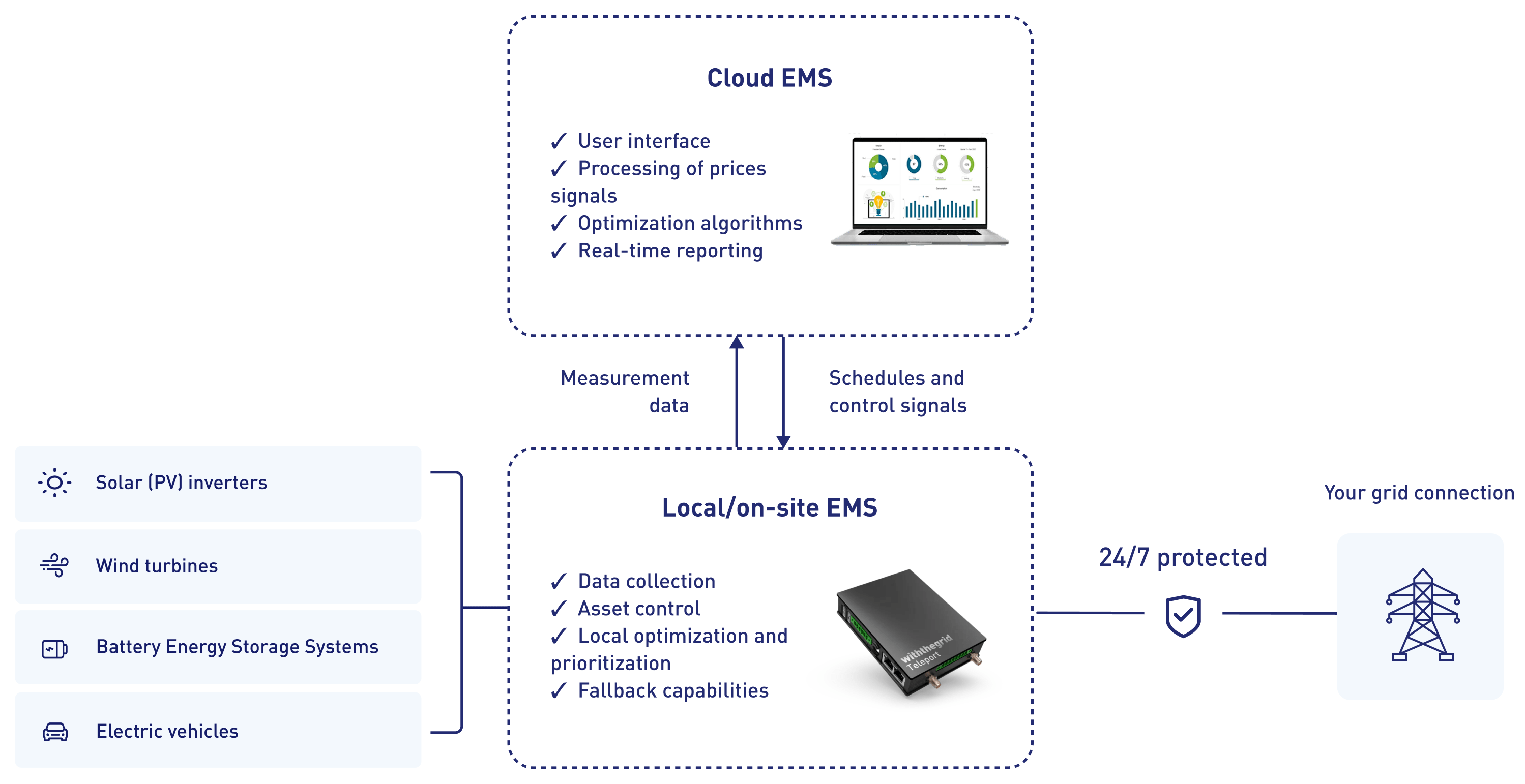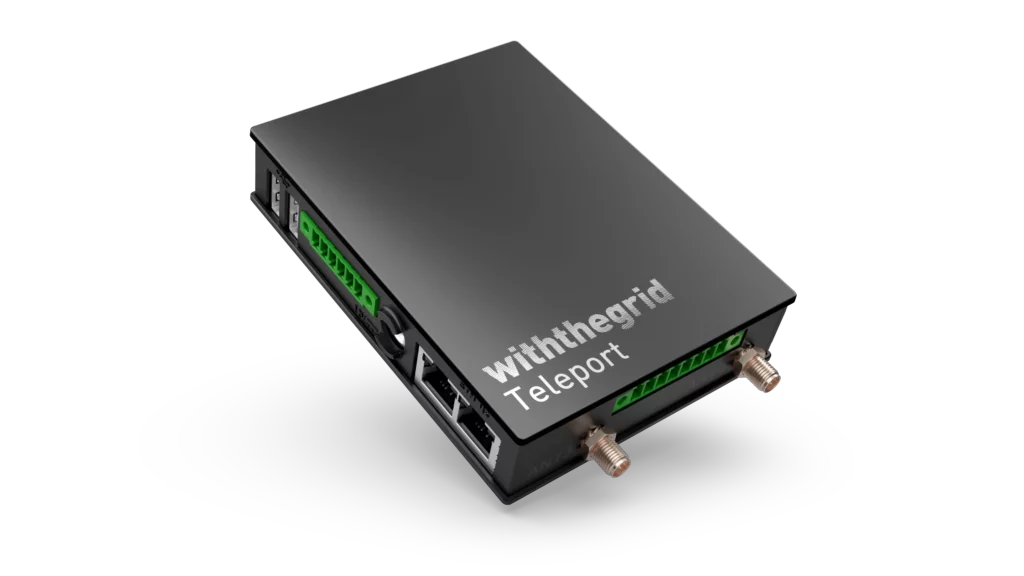Home → Blog → Flexibility → What is an on-site Energy Management System (EMS)?
By
Anaïs Wampack
Published on:
03/04/2024
An Energy Management System (EMS) is a tool combining hardware and software designed to effectively manage the production, storage and consumption of energy. The end goal of an EMS is to help organizations maximize energy efficiency, reduce costs, and promote sustainability by making automated and smarter energy decisions.
On-site EMS vs. cloud EMS
An on-site EMS is a localized version of energy management, typically installed at the same location as the energy assets it manages.
Unlike a cloud-based EMS, which rely on remote servers and internet connectivity to function, an on-site EMS is physically present at the site of the energy assets. This setup allows for real-time data processing and direct control over the energy systems, including generation units, storage systems and consumption loads.
The primary purpose of an on-site EMS is to optimize the balance between energy production and consumption directly at the source (“behind the meter”), and ensure functionality in case internet connectivity is lost.
Functionalities of an on-site EMS
An on-site EMS is designed to optimize energy usage and enhance operational efficiency at a local level. This system offers several key functionalities aimed at improving both energy reliability and cost-effectiveness:
- Fallback Capabilities:
In the event that the connection to a cloud-based EMS is lost, the on-site EMS ensures continuous energy management by executing predefined asset strategies or switching to a safe mode until connectivity is restored. This ensures that energy operations remain uninterrupted, safeguarding against potential disruptions.
- Load balancing and peak shaving:
By monitoring real-time energy consumption, an on-site EMS can adjust the load dynamically. This involves distributing energy effectively across different assets of a site to ensure optimal performance of equipment and avoidance of overloads. This is crucial for reducing energy costs and maintaining system stability. For instance, it might balance the energy load among several electric vehicle (EV) chargers to maintain efficient operation without overtaxing the power supply.
On the other hand, peak shaving involves reducing the energy load during peak hours to avoid high energy charges and reduce strain on the grid. It can be done by directly reducing the consumption, or by using connected battery storage systems. For example, the system might use battery storage to power air conditioning units during the hot summer months, thus reducing the need to draw expensive power from the grid.
- Proportional peak shaver:
In case of peak shaving with multiple batteries, the state of charge can fluctuate between the batteries. In order to not have one battery fully depleted and the other one still full, the on-site EMS should distribute the battery setpoints proportionally based on the nominal power of the batteries, but also considering the state of charge in that decision.
- Feed-in limits:
This strategy involves dynamically adjusting solar and wind asset power production based on real-time self-consumption and the power generated by the installation. The aim is to not exceed the static or dynamic grid feed-in limit during peak periods, curtailing excess power.
- Dynamic grid limits:
Due to grid congestion, grid operators are using dynamic grid limits to cap the capacity of the connection during specific times. The on-site EMS ensures that, during those time periods, total consumption does not exceed this (lower) grid capacity.
- Local prioritisation:
The EMS also prioritizes energy flows within the site. For example, during periods of high solar output, it can direct excess energy to power-intensive operations such as cooling in a freeze house, or store it in batteries for later use, like charging EVs. This not only maximizes the use of renewable energy (HBEs) but also enhances the overall efficiency of the site.
- Prioritising steering signals:
With the ability to participate in various energy markets (balancing markets such as FCR, aFRR, passive unbalance and congestion markets), assets connected to the EMS can receive multiple steering signals. The system must prioritize these appropriately, ensuring that signals related to grid congestion take precedence over those from balancing markets.
Benefits of an on-site EMS
- Reduced energy costs:
By optimizing how energy is produced, stored and consumed, organizations can significantly lower their costs.
- Optimized energy flows:
The on-site EMS can ensure the share of green electricity is maximized.
- Protected grid connection:
An on-site EMS always ensures that energy feed-in or take-off never exceeds the contracted grid limits. This protection prevents penalties associated with exceeding power limits and ensures compliance with energy regulations.
- Prioritisation of steering signals:
An on-site EMS can ensure that market signals are prioritized in the right manner, according to DSO requirements.
Combining on-site and cloud EMS
While on-site EMS are effective for immediate, localized control and optimization, combining these systems with a cloud EMS creates the final desired solution for the end consumer.
On-site systems can focus on real-time monitoring and rapid response to changes in energy loads and production. In contrast, cloud EMS can perform more complex analytics, gather historical and market data insights, and optimize long-term energy strategies. It’s also usually accompanied by an interface on which the users can visualize the data and change the parameters. This combination of specialized types of EMS allows for a comprehensive approach to energy management, leveraging both immediate and predictive insights to foster a more resilient energy infrastructure.

The Teleport as on-site EMS
Reduce costs by optimizing your local grid
Are you looking to optimize your local energy production, storage and consumption while staying within your contracted grid limit?
With the Teleport Gateway, you can manage all your assets via a single API while keeping your grid connection 24/7 protected.
Simplify connectivity, protect your grid connection
Conclusion
In conclusion, an on-site EMS is an essential part for any organization looking to take control of its energy consumption and optimize its production processes. When coupled with cloud technology, it forms a robust system capable of driving significant energy efficiency and cost reduction. As businesses continue to grow and evolve, the integration of advanced EMS solutions will undoubtedly play a critical role in shaping smarter energy practices.

Contact us
To learn more about the Teleport as an on-site EMS solution and how it can benefit your business, contact us today.


